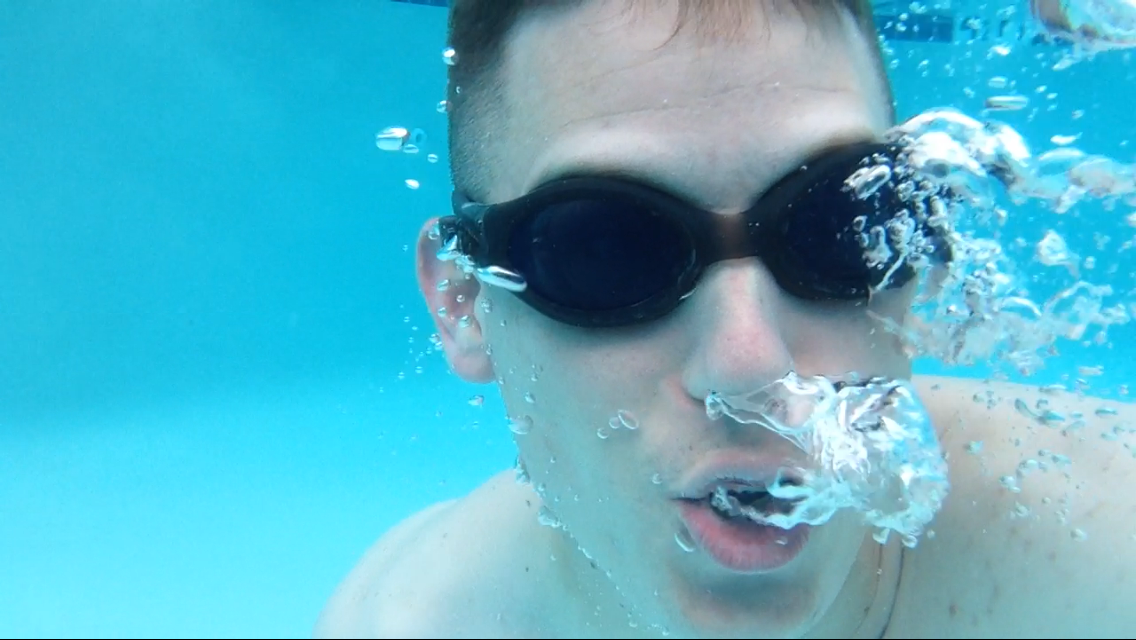I feel like it would be useful to know exactly how much alcohol is in a can or a bottle. Also why is alcohol the only thing measured in percentages and not sugar or caffeine or medicine?
I haven’t seen anyone really answer the why of it, which is that the industry developed using a floating glass tool called a hydrometer which measures the specific gravity, or density, of liquids.
When you boil the wort to prepare for fermentation, you end up with a sugary liquid that is denser than water or alcohol. Water has a specific gravity of one, and the specific gravity of the wort is increased by everything you dissolved into it. You would float a glass hydrometer in it and lets say you get a reading of 1.055.
After fermentation the yeast has converted much of the sugar to alcohol and decreased the specific gravity. You measure a second time, and multiply the difference by a constant factor to get ABV. let’s say after fermentation you got a reading of 1.015.
1.055 - 1.015 = 0.04
0.04 * 131.25 = 5.25% ABVWe label with ABV because that was how it was calculated, and remained the same regardless of the quantity served.
There is a similar process for distilling as well. Before these methods people didn’t know the exact amounts, which led to fun things like navy and admiral strength.
Edit: also the 131 figure really should vary based on temperature since it is derived from the ratios of the density of ethanol and water. The higher the ABV the more important it is to factor temperature, and distilling requires more sensitive measurements and tools. But for beer, using 131.25 is fine and has about 0.2% error up to around 10% ABV.
That still doesn’t give us a reason why customers have this special calculated value. You could just multiply the volume by this percentage to get the absolute value. Why is the percentage preferred over the volume? I see no reason for either side.
You have to print a separate label for each bottle size then. Much easier to print something like ‘10% strength’ and slap the same label on all of your barrels and bottles regardless of their volume.
You still have to show total volume on each bottle. So the label is different anyway. Plus, it could have been done as they do to show singer content - amount per serving size and servings per container.
Present age does nearly the same thing though. 20% simply means 20ml in serving size of 100ml.
Like I said, because the percent doesn’t change with the volume served. If you are an 1800s brewer you can calculate the ABV from samples, and subsequently sell kegs of various sizes, bottles, which in turn can be served in various amounts and the percent doesn’t change. And the industry never changed, nor the laws written. So it’s the way it is because that is how they used to do it and how laws were written and there hadn’t been a motivation for people to change that.
In a word - tradition.
Also, it’s practical. If you know something is twice as concentrated (12% instead of 6%) you know to drink it more carefully, rather than if you get a jug of something and it just says how much alcohol is in there, then you have to mentally calibrate how strong it is by considering the volume of the jug vs. how much alcohol there is.
Yup.
We do lots of things as a society because we’ve always done them that way, or it’s good enough, and not enough reason to go through the effort of changing everything including legal language, etc.
Happily, in this case I think ABV is about the best way we could have inherited, maybe only second to alcohol by weight in terms of consistency across temperature.
deleted by creator
A percentage is going to be more useful to a consumer than a volume anyway, especially for bottles that are consumed in part. 40% tells you a drink is going to be strong, without any further math based on whatever size drink you have poured yourself. If you wanted to know the volume alcohol of a poured drink, you’d have to linearly interpolate according to the size of glass you poured yourself, which is one step beyond just multiplying the alcohol percentage by the volume of the glass.
So in conclusion, labeling the volume of alcohol on a bottle is only practical for beer bottles and prepackaged cocktails, etc. If you do want to know the volume of alcohol consumed, simply multiply the volume of drink consumed by the ABV%.
Should be relatively easy to figure out if you know both the total amount of liquid and the percentage of alcohol.
100ml bottle that’s 40% ABV would be 40ml of alcohol.
As a consumer, I think it makes more sense to have the percentage by volume. Firstly, it makes the general pattern of alcohol content much clearer so we get a better intuition of what we’re getting into. Beers generally hover around 5%, wines at 10-15%, and spirits at 20% and above.
Building on that, people don’t generally remember the volume of pure alcohol they can handle, but they do remember, for example, that three glasses of wine is the most that they should drink. If you’re presented beer, then along with your intuition of their relative alcohol content, you can easily approximate that you can handle about twice as much volume since it’s about half the alcohol by volume. And similar if you have spirits, then you can reduce that volume to half or less.
How would you estimate it given a volume of alcohol instead? I know I can handle three glasses of this one particular kind of wine. If I have another type of wine with a different alcohol content and different bottle size, I’ll have to math out how much alcohol will be in my glass: (Volume of glass)*(total alcohol context)/(Volume of wine bottle). Most people would give up before even trying to come up with this formula. Now how much alcohol did I have the last time when I had three glasses of wine? The bottle said something like 80ml of alcohol. But how big was it? That’s two large numbers that you need to remember, and since they’re so different from one bottle of wine to the next, you likely don’t remember any of it.
Secondly, it affected flavour. In general, you can taste how much alcohol is in a certain drink and that depends on the relative volume of alcohol, not the absolute amount.
To add to this, %ABV is what’s actually measured by distillers when distilling, unless they’re doing it entirely by smell/taste. The first and last parts will have less alchohol since everything evaporates off at different temperatures. (the tail is mostly water. the head, IIRC is mostly methanol or whatever else.)
The total amount of alchohol changes depending on how it’s packaged or sold off, or if you’re pouring a double, so people will need to do math anyhow; unless it’s a single serving package. (and even then… they might not drink it all. blashphemy, I know.)
I think alcohol can’t be kept pure in normal conditions, it would turn into a gas. So it is diluted by necessity. Knowing the full volume of the thing is certainly better than knowing only the quantity of alcohol without knowing the degree of dilution.
It is not the only product to be indicated this way. All diluted chemicals are. I think syrup is also?
The boiling point of pure ethanol is 78°C / 173°F [1], so it would not turn into a gas at normal conditions.
Pure ethanol is very hard to produce because it forms an azeotrope with water in the ~96% [1] range, meaning it cannot be distilled further than that, it must be separated by other means.
Alcohol in spirits is usually diluted because of taxes on higher percentage alcohol, consumer preference, or being able to make more bottles with the same amount of ethanol. I believe using percentages for alcohol began when ye olde England was putting taxes based on the percentage of alcohol in the drink [2].
[1] - https://en.wikipedia.org/wiki/Ethanol [2] - https://en.wikipedia.org/wiki/Alcohol_proof
it would not turn into a gas at normal conditions.
It does: https://en.wikipedia.org/wiki/Vapor_pressure. In an airtight container you would have an equilibrium of alcohol vapor and liquid. In open-atmosphere, the atmosphere basically behaves like an infinitely large volume for the vapor - so the alcohol will completely vaporize (and cool the surface it is on in order to do so).
It’s also trivial to demonstrate by pouring alcohol onto a surface, it disappears in seconds. Same with gasoline and numerous other liquids you’ve surely seen do this (another example is hand sanitizer, which is basically pure alcohol).
Being diluted doesn’t really help with any of this though. Also alcohol is kept in bottles, which are usually airtight until they are first opened.
I mean sure, but you could say that about any liquid, or even any solid for that matter (with sublimation). But that’s not really what I was talking about when I responded.
It was what the GP was, though.
To take your train of thought one step further, think about gasoline. Gasoline has a high vapor pressure, maybe even higher vapor pressure than ethanol. Would you say that gasoline is a liquid at normal conditions?
If you throw gasoline out on to the pavement it will evaporate away. If you keep it in a gasoline can it will not. In a gasoline can the liquid and gas will reach equilibrium, though you’ll certainly have slightly less liquid than what you started with. If the can isn’t sealed then, yes, all the gasoline will eventually evaporate away - even at STP.
And, again, this is all trivial to test at home by using some hand sanitizer. Another example is your skin does not remain wet with water forever, despite human skin temperature not being 100°C. It’s an everyday phenomena, I’m not sure what you’re trying to argue against here. It’s not my “line of thinking,” it’s objectively reality.
As for your distillation problem, the issue isn’t that some alcohol remains in the water - it’s that some water evaporates alongside the alcohol during the distillation process at the boiling point of alcohol - due to, guess what, vapor pressure. That’s called an azeotrope - clicking through to that Wikipedia page might have helped.
👍
I feel like it would be useful to know exactly how much alcohol is in a can or a bottle
They always list the total volume of the liquid so you can easily get the absolute alcohol content with the percentage.
Don’t most consumables list their volume?
1liter of beverage at 5% ABV is 50ml of alcohol. For example
I doubt it will be of any benefit. How would it help if you knew that bottle of liqueur contans 125ml of pure alcohol? Or that bottle of Sauvignon Blanc contains 98ml? Or a can of beer 15ml?
I suppose you need to multiply. And you need to factor in all of that additional info anyways. How much wine do you drink? The whole bottle? How much alcohol can you tolerate? (What do you weigh…) And how much sugar is in the beverage, because that also affects things and is extra work for your liver, too.
But it’s a good question. And sugar, caffeine etc are in fact measured in percentage. At least in europe you always have a measurement per 100ml or 100g written on the packaging, which is kind of the percentage. Interestingly enough it’s not written on wine, liqueur etc.
There are special rules for labelling for alcohol given the obvious risks of consuming more than you realised.
Here alcohol must show the percentage alcohol content, but alcohol designed to be consumed as-is (without mixing) also states the number of standard drinks.
The number of standard drinks is the same as the “amount of alcohol” you mentioned.
Other ingredients like sugar aren’t shown as a percentage because manufacturers don’t want to show it, and it’s not required by law because although there are risks of excess consumption, they’re not “immediate risk to life” type risks.
Yeah, NZ & Aus both have a ‘standard drinks’ system.
My guess is that larger quantities of alcohol (particularly bottles of spirits but also wine) simply aren’t intended to be drunk by one person in one sitting. Total volume of alcohol isn’t that useful; it’s more useful to be able to work out how much is in one shot or one glass.
This is especially important when you look at the same product being sold by the shot/bottle/cask/barrel, or being able to buy a gallon of it in your own container historically.
Yep, in the UK we have both abv and units of alcohol on most drinks. So you can go by whichever makes most sense for you.
Just thinking. Maybe there’s a non linear relation between the uptake and the amount of alcohol. As for other products, they usually have a nutritional information table per 100g that you can thus read as percentages.
Since everyone pretty much nailed the ABV% answer I’ll take a crack at the other. I’m guessing that the reason they don’t list other ingredients, like what food producers are required to do, is because most countries are concerned about the alcohol content more than anything else that’s in it.
In the US, and I suspect other countries, the agency that regulates alcohol is different than the one that regulates food. In the US alcohol is regulated by the ATF and food by the FDA. Since it is the FDA rules that require nutritional labels and ingredients and not the ATF, most brands don’t list much.
Additionally, alcohol recipes are often considered trade secrets and closely held which might be why rules haven’t been introduced in many places.
Here is an article that talks a little more about different breweries and if they keep their ingredients secret or not.
Years ago, for the US I read the answer was lack of demand from consumers.
Cue ready-to-drink products gaining popularity with newer generations and some have hit the market with nutritional labeling. Would be nice to see it mandatory across the board at this point.
You wouldn’t take a shot of beer with 5% ABV
Nor would you take a pitcher of vodka
ABV works for all types of packages. It could be helpful to know that a can of beer contains 18.6ml of alcohol, sure, but what about a bottle of whiskey or vodka? Is it better to know that it’s 40% alcohol or 300ml? Should a bar publish that a keg has 4.2 liters of alcohol in it?
With ABV you can compare alcohol across volumes.









